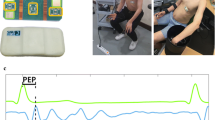Abstract
Severe blood pressure changes are well known in hemodialysis. Detection and prediction of these are important for the well-being of the patient and for optimizing treatment. New noninvasive methods for this purpose are required. The pulse wave transit time technique is an indirect estimation of blood pressure, and our intention is to investigate whether this technique is applicable for hemodialysis treatment. A measurement setup utilizing lower body negative pressure and isometric contraction was used to simulate dialysis-related blood pressure changes in normal test subjects. Systolic blood pressure levels were compared to different pulse wave transit times, including and excluding the cardiac preejection period. Based on the results of these investigations, a pulse wave transit time technique adapted for dialysis treatment was developed and tried out on patients. To determine systolic blood pressure in the normal group, the total pulse wave transit time was found most suitable (including the cardiac preejection period). Correlation coefficients were r = 0.80 ± 0.06 (mean ± SD) overall and r = 0.81 ± 0.16 and r = 0.09 ± 0.62 for the hypotension and hypertension phases, respectively. When applying the adapted technique in dialysis patients, large blood pressure variations could easily be detected when present. Pulse wave transit time is correlated to systolic blood pressure within the acceptable range for a trend-indicating system. The method's applicability for dialysis treatment requires further studies. The results indicate that large sudden pressure drops, like those seen in sudden hypovolemia, can be detected.
Similar content being viewed by others
References
J Passauer E Bussemaker P Gross (1998) ArticleTitleDialysis hypotension: do we see light at the end of the tunnel? Nephrol Dial Transplant 13 3024–3029
G Ligtenberg PJ Blankestijn PL Oey GH Wieneke AC van Huffelen HA Koomans (1997) ArticleTitleCold stress provokes sympathoinhibitory presyncope in healthy subjects and hemodialysis patients with low cardiac output Circulation 95 2271–2276
AI Arieff (1994) ArticleTitleDialysis disequilibrium syndrome: current concepts on pathogenesis and prevention Kidney Int 45 629–635
RR Steuer JK Leypoldt AK Cheung HO Senekjian JM Conis (1996) ArticleTitleReducing symptoms during hemodialysis by continuously monitoring the hematocrit Am J Kidney Dis 27 525–532
P Lantelme C Mestre M Lievre A Gressard H Milon (2002) ArticleTitleHeart rate: an important confounder of pulse wave velocity assessment Hypertension 39 1083–1087
MJ Drinnan J Allen A Murray (2001) ArticleTitleRelation between heart rate and pulse transit time during paced respiration Physiol Meas 22 425–432
W Chen T Kobayashi S Ichikawa Y Takeuchi T Togawa (2000) ArticleTitleContinuous estimation of systolic blood pressure using the pulse arrival time and intermittent calibration Med Biol Eng Comput 38 569–574
D Franchi R Bedini F Manfredini S Berti G Palagi S Ghione A Ripoli (1996) ArticleTitleBlood pressure evaluation based on arterial pulse wave velocity Comput Cardiol 23 108–111
M Nitzan B Khanokh Y Slovik (2002) ArticleTitleThe difference in pulse transit time to the toe and finger measured by photoplethysmography Physiol Meas 23 85–93
RA Allen JA Schneider DM Davidson MA Winchester CB Taylor (1981) ArticleTitleThe covariation of blood pressure and pulse transit time in hypertensive patients Psychophysiology 18 301–306
JD Lane L Greenstadt D Shapiro E Rubinstein (1983) ArticleTitlePulse transit time and blood pressure: an intensive analysis Psychophysiology 20 45–49
GV Marie CR Lo J van Jones DW Johnston (1984) ArticleTitleThe relationship between arterial blood pressure and pulse transit time during dynamic and static exercise Psychophysiology 21 521–527
DB Newlin (1981) ArticleTitleRelationships of pulse transmission times to pre-ejection period and blood pressure Psychophysiology 18 316–321
T Länne J Lundvall (1992) ArticleTitleMechanisms in man for rapid refill of the circulatory system in hypovolemia Acta Physiol Scand 146 299–306
WG Chochran (1989) Statistical methods EditionNumber8th edn. Iowa State Press Ames
RA Wolthuis SA Bergman AE Nicogossian (1974) ArticleTitlePhysiological effects of locally applied reduced pressure in man Physiol Rev 54 566–595
G Ligtenberg PJ Blankestijn HA Koomans (1998) ArticleTitlePresyncope during progressive hypovolaemia simulated by lower body negative pressure is not prevented by high-dose naloxone Nephrol Dial Transplant 13 398–403
MH Pollak PA Obrist (1983) ArticleTitleAortic-radial pulse transit time and ECG q-wave to radial pulse wave interval as indices of beat-by-beat blood pressure change Psychophysiology 20 21–28
CF Wippermann D Schranz RG Huth (1995) ArticleTitleEvaluation of the pulse wave arrival time as a marker for blood pressure changes in critically ill infants and children J Clin Monit 11 324–328
B El-Asir L Khadra AH Al-Abbasi MMJ Mohammed (1996) ArticleTitleTime-frequency analysis of heart sounds Proc IEEE Tencon Digital Signal Proc Appl 2 553–558
Author information
Authors and Affiliations
Corresponding author
Rights and permissions
About this article
Cite this article
Ahlstrom, C., Johansson, A., Uhlin, F. et al. Noninvasive investigation of blood pressure changes using the pulse wave transit time: a novel approach in the monitoring of hemodialysis patients. J Artif Organs 8, 192–197 (2005). https://doi.org/10.1007/s10047-005-0301-4
Received:
Accepted:
Issue Date:
DOI: https://doi.org/10.1007/s10047-005-0301-4




